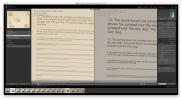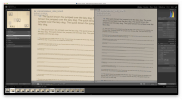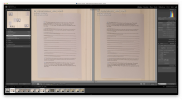Based on my testing the 24mm is at its best when you stop it down to f/3.2, from there on the diffraction just eats up the quality, so for photography f/3.2 is what you want unless you are shooting fireworks, long exposure or simmilar.
Your exposure times are too slow for a test, the gimbal can introduce trepidation and the long exposure is definitely introducing noise. Do them on daylight conditions or use a potent enough continuous light source to rise the exposure times to at least 1/250.
The 24mm is expected to have more optical problems because:
- The 24mm camera sensor is way bigger but they share the same compact design.
- Correcting the lens distortions on a compact design is more difficult than on a normal-sized lens.
- The greater the FOV the more difficult to have undistorted/sharp image projection all over the sensor
- The bigger the sensor the more difficult to have a lens performing good all over the circle of image (that being said, there's a design flaw on the Mavic 3 24mm where the image doesn't cover the entire sensor and it relies on a DNG crop to achieve it).
So yep, due to the size and weight restrictions, it is easier to have a 70 mm equivalent on a 1/1.3 sensor performing good rather than a 24mm equivalent on a 4/3 sensor.
IMO you can't expect more of a <900g drone to be honest, if you shoot pics at ground level you can easily realize that the camera is performing quite good compared to a standard 35mm DSLR... that weights more than the entire flying machine.
You can pick an inspire or put a DSLR on a custom drone, but you can unfold a <900g and start flying in less than a minute... or mess with a bulky drone and miss the shot. Big drones are basically "restricted" to controlled environments, such as movies or photoshoots, but for the average landscape/architecture photographer you want to stick to the <900g and
M3 4/3 24 mm is the best you can get atm.
PS: Most people these days get fooled by usharpen mask match bands, but that won't fool any seasoned photographer. Over sharp, over post process, those things should be dead since 2006 digital boom, but now that everyone with a phone thinks it's a photographer and that their "50MP" camera with a sensor smaller than my pinky nail is delivering "professional" results and tons of gigabytes or pure crap are uploaded each second to the internet to be compressed and shown at a crappy resolution on small uncalibrated screens... is easy to misunderstand what a good camera is about.
For me, the main problem of the
M3 camera is that there aren't camera matching Hasselblad profiles available on Lightroom, which is a pitty as you have to use the color checker to get a decent DNG profile.
PPS: Removing the front filter should improve the quality a bit as it's just a piece of glass that is not a part of the lens, but it's more risky to the lens, so I just leave it on.



















